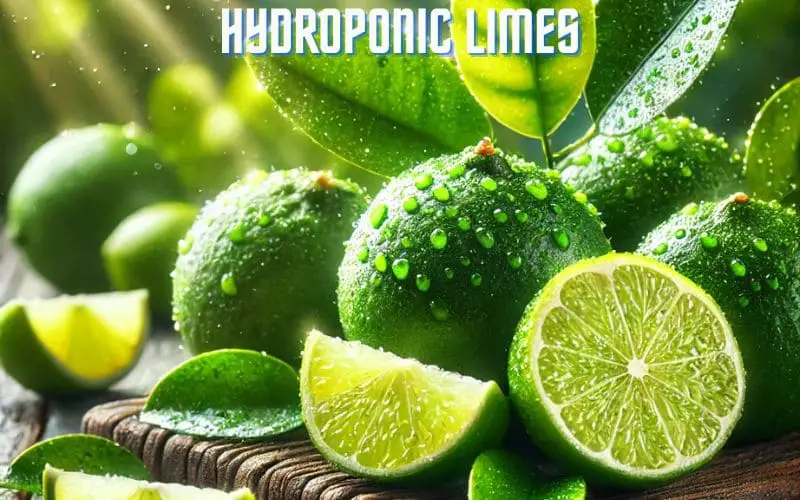Growing Hydroponic Limes: Your Guide To Fresh Citrus at Home

Introduction
Welcome to the world of hydroponic limes! In this comprehensive guide, we will explore the fascinating realm of growing limes hydroponically. As we delve into the benefits, methods, and best practices, you will gain valuable insights into this innovative and sustainable approach to lime cultivation.
Why Grow Limes Hydroponically
Before delving into the specifics of hydroponic lime cultivation, it’s essential to understand the driving factors behind choosing this innovative approach. Hydroponic lime cultivation offers several distinct advantages over traditional soil-based methods, including enhanced control over growing conditions, resource efficiency, and minimized environmental impact.
Benefits of Hydroponic Limes
1. Sustainable Growth
Hydroponic lime cultivation represents a sustainable and eco-friendly approach to lime production. By optimizing water and nutrient usage, this method minimizes waste and environmental impact while maximizing the yield of high-quality limes.
- Efficient use of water resources
- Minimization of waste products
- Reduction of environmental impact
Additionally, hydroponic lime cultivation significantly reduces the need for pesticides and herbicides, promoting a healthier ecosystem and safer produce for consumers.
2. Controlled Environment
Hydroponic lime cultivation offers a highly controlled environment that allows for precision management of growth conditions. This ensures that the lime plants receive optimal care throughout their growth cycle. The following key factors contribute to creating such a controlled environment:
- Light Regulation: By utilizing artificial lighting and carefully monitoring the duration and intensity of light, hydroponic lime cultivation can ensure that plants receive consistent and appropriate light levels for maximum photosynthesis and growth.
- Temperature Management: Maintaining stable temperature levels is crucial for lime plants to thrive. Hydroponic systems offer the capability to regulate temperature with precision, creating an ideal growing environment at all times.
- Humidity Control: Proper humidity levels play a significant role in the overall health of lime plants. Hydroponic setups allow for the careful adjustment of humidity to optimize plant growth and minimize the risk of diseases and pests.
- Nutrient Optimization: One of the key advantages of hydroponic lime cultivation is the ability to provide a precisely controlled balance of essential nutrients. This ensures that the plants have access to the perfect nutrient mix at all stages of their growth, resulting in healthier and more flavorful limes.
By effectively managing these factors, hydroponic lime cultivation offers a level of control that is unmatched in traditional soil-based cultivation, resulting in superior lime quality and consistency.
3. Quality and Flavor
Hydroponic limes are known for their exceptional quality and vibrant flavor, often surpassing those grown in traditional soil gardens. Because hydroponic systems allow precise control over nutrients, water, and environmental conditions, the plants receive everything they need to thrive without competition from weeds or soil-borne diseases. This results in limes that are juicy, tangy, and bursting with a consistent, zesty flavor. The controlled environment also ensures that the fruit develops a smooth, blemish-free skin, making it as visually appealing as it is delicious. Hydroponic limes are a favorite for culinary uses, from fresh garnishes to enhancing beverages, thanks to their bright, clean taste and reliable quality.
How to Grow Hydroponic Limes
1. Choosing the Right System
When embarking on the journey of hydroponic lime cultivation, selecting the appropriate hydroponic system is crucial. Factors such as space availability, desired yield, and personal preferences play a significant role in determining the most suitable hydroponic system for your lime-growing endeavors.
- Consideration of Space: Different hydroponic systems vary in space requirements, and it’s important to choose one that fits the available space of your cultivation area. For smaller spaces, vertical hydroponic systems may be more suitable, while larger areas may accommodate nutrient film technique (NFT) systems.
- Yield Expectations: Each hydroponic system can produce different yields, and understanding the expected yield of a system is essential. Factors such as the number of lime plants, nutrient delivery method, and lighting will impact the overall yield.
- Personal Preferences: Some growers may prefer the simplicity of a passive hydroponic system, while others may opt for the precise control offered by aeroponic systems. It’s important to consider your own preferences and comfort level when selecting a hydroponic system.
Additionally, the choice of hydroponic system will influence the maintenance routines and nutrient delivery methods. Some systems require more frequent monitoring and maintenance, while others offer automated solutions for nutrient delivery and environmental control.
Choosing the right hydroponic system sets the foundation for a successful lime-growing venture and can significantly impact the overall efficiency and productivity of your hydroponic cultivation.
2. The Growing Process
How to Set Up a Hydroponic Lime Garden at Home
Growing limes hydroponically allows you to enjoy fresh, juicy citrus right from your home! Follow these simple steps to set up your system.
Materials Needed:
- Hydroponic System
- Deep Water Culture (DWC) or Ebb and Flow system is ideal for limes.
- Container or Reservoir
- A 5–10-gallon container to hold nutrient water.
- Net Pots
- Medium-sized net pots to hold the lime plant.
- Grow Medium
- Expanded clay pellets or coconut coir.
- Air Pump and Air Stone
- For oxygenating the nutrient solution.
- Hydroponic Nutrients
- Citrus-friendly nutrients with a balanced mix of nitrogen, potassium, and phosphorus.
- pH Testing Kit and pH Adjusters
- To maintain the nutrient solution’s pH between 5.5 and 6.5.
- Grow Lights (Optional)
- LED grow lights if natural sunlight is limited.
- Lime Saplings or Seeds
- Healthy lime saplings are recommended for quicker results.
- Trellis or Plant Support (Optional)
- To support the growing lime plant.
Step-by-Step Instructions:
- Choose a Location
- Select a spot with good air circulation and access to sunlight or set up grow lights.
- Prepare the Hydroponic System
- Set up your chosen system (DWC or Ebb and Flow). Ensure the reservoir is clean and can hold the nutrient solution.
- Fill with Nutrient Solution
- Mix hydroponic nutrients into water, following the manufacturer’s instructions. Adjust the pH to 5.5–6.5 using the pH testing kit.
- Plant the Lime Saplings
- Place the saplings in net pots filled with the grow medium. Position the roots to hang slightly into the nutrient solution.
- Aerate the System
- Connect the air pump to the air stone and place it in the reservoir to oxygenate the solution.
- Set Up Lighting (If Needed)
- Position grow lights 12–18 inches above the plants and use a timer for 12–14 hours of light daily.
- Monitor and Adjust
- Regularly check the pH and nutrient levels of the solution. Top up the reservoir as needed to maintain consistent levels.
- Provide Plant Support
- As the lime plant grows, use a trellis or stakes to support the branches and help them bear the weight of the fruit.
- Prune and Maintain
- Trim excess foliage to encourage airflow and sunlight penetration. Remove any yellow or unhealthy leaves.
- Harvest
- Limes are ready to harvest when they reach their full size and have a bright green or yellow color, depending on the variety.
By following these steps, you’ll soon have a thriving hydroponic lime garden producing fresh fruit for your use! Let me know if you need additional tips on troubleshooting or enhancing your setup.
Harvesting and Maintenance
1. Harvesting Practices
Harvesting hydroponically grown limes requires precision and care to ensure the preservation of quality and flavor. Understanding the indicators of fruit ripeness and implementing proper harvesting techniques is crucial for reaping the rewards of your hydroponic lime cultivation efforts.
- Proper Timing: Harvesting should be done when the limes are at peak ripeness to ensure the best flavor and juiciness.
- Indicators of Ripeness: Look for the color change, firmness, and aroma as indicators of ripeness in hydroponically grown limes.
- Harvesting Techniques: Gently twist the limes from the plant to avoid damaging the delicate hydroponic roots. Use sterilized tools to cut the fruits to avoid contamination.
- Post-Harvest Handling: After harvesting, handle the limes with care to prevent bruising and damage to the skin. Store them in a cool, dry place to maintain freshness.
2. Maintenance Tips
Maintaining hydroponic limes involves regular monitoring and care to ensure the plants thrive and produce high-quality fruit. Start by checking the nutrient solution every few days to ensure the pH stays between 5.5 and 6.5, which is optimal for lime growth. Replenish the nutrients as needed, following the manufacturer’s guidelines to avoid underfeeding or overfeeding the plant. Oxygenation is crucial, so ensure the air pump and air stone are functioning properly to keep the roots healthy. Also, keep an eye on the water level in the reservoir and top it up with clean water as necessary to prevent the roots from drying out.
In addition to maintaining the hydroponic system, care for the plant by providing adequate lighting—12–14 hours of light daily, either from natural sunlight or LED grow lights. Prune the lime plant regularly to remove dead or yellowing leaves, which improves airflow and reduces the risk of pests and diseases. Keep the environment stable by avoiding drastic changes in temperature, as limes prefer a warm, consistent climate. Finally, inspect the plant for signs of pests like aphids or spider mites, and take immediate action if issues arise to ensure your hydroponic lime garden remains healthy and productive.
Conclusion
As we conclude this comprehensive exploration of hydroponic lime cultivation, it becomes evident that this innovative approach offers a multitude of benefits, ranging from sustainability and quality to controlled growth environments. By embracing the knowledge and best practices outlined in this guide, you are well-equipped to embark on your own journey of hydroponic lime cultivation, contributing to sustainable agriculture and enjoying the delightful yields of high-quality limes.
